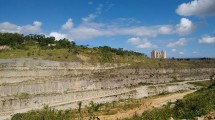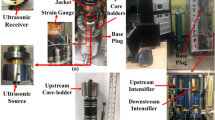Abstract
In this study, possibility of geological storage of CO2 into an Iranian hydrocarbon reservoir is investigated as a method of enhanced oil recovery (EOR). For this purpose, a stainless steel sand packed model, containing rock and brine, was used to simulate the reservoir condition and CO2 injection. Subsequently, CO2–rock–brine interactions (dissolution and deposition of minerals) due to CO2 injection, under reservoir pressure and temperature condition (136 bar and 80 °C), was studied with ion chromatography and pH measurement at time intervals of 7, 14 and 30 days. In addition, the rock structure was identified by X-ray diffraction analysis. Results showed that up to 14 days, pH and the concentration of cations (sodium, calcium, magnesium, and potassium) and anions (chloride and sulfate) were progressively increased. However, in 30 days, assays, both pH and concentration, were decreased compared to those of 14 days of test results. Consequently, the dissolution process was observed to be the dominant phenomenon in the early days; then, the deposition of secondary minerals became the main process during the performed test. Finally, in the case of selecting the right place for CO2 injection, to avoid the porosity and permeability decrease near the well, this method can be used as a safe technique for CO2 geological storage at specific time intervals in the studied oil reservoir.





Similar content being viewed by others

References
Appelo C, Postma D (2005) Geochemistry, groundwater and pollution, 2nd edn. CRC Press, Amsterdam
Assayag N, Matter J, Ader M, Goldberg D, Agrinier P (2009) Water–rock interactions during a CO2 injection field-test: implications on host rock dissolution and alteration effects. Chem Geol 265:227–235
Bachu S, Adams J (2003) Sequestration of CO2 in geological media in response to climate change: capacity of deep saline aquifers to sequester CO2 in solution. Energy Convers Manage 44:3151–3175
Bertier P, Swennen R, Laenen B, Lagrou D, Dreesen R (2006) Experimental identification of CO2–water–rock interactions caused by sequestration of CO2 in Westphalian and Buntsandstein sandstones of the Campine Basin (NE-Belgium). J Geochem Explor 89:10–14
Blunt M, Fayers FJ, Orr FM Jr (1993) Carbon dioxide in enhanced oil recovery. Energy Convers Manage 34:1197–1204
Carroll SA, McNab WW, Torres SC (2011) Experimental study of cement-sandstone/shale-brine-CO2 interactions. Geochem Trans 12:9
Chen P, Saeedi A, Noble R (2017) An experimental study of CO2 saturated brine reaction with berea sandstone. SPE Western Regional Meeting. Society of Petroleum Engineers
Fischer S, Liebscher A (2013) Mineral solubilities in CO2-saturated NaCl brine systems. Procedia Earth Planet Sci 7:260–263
Fischer S, Liebscher A, Wandrey M, Group CS (2010) CO2–brine–rock interaction—first results of long-term exposure experiments at in situ P-T conditions of the Ketzin CO2 reservoir. Chemie der Erde-Geochem 70:155–164
Garcia-Rios M, Cama J, Luquot L, Soler JM (2014) Interaction between CO2-rich sulfate solutions and carbonate reservoir rocks from atmospheric to supercritical CO2 conditions: experiments and modeling. Chem Geol 383:107–122
Gharbi O (2013) Fluid-rock interactions in carbonates: applications to CO2 storage. PhD Thesis, Imperial College London, Londom, UK
Guo F, Aryana SA, Wang Y, McLaughlin JF, Coddington K (2019) Enhancement of storage capacity of CO2 in megaporous saline aquifers using nanoparticle-stabilized CO2 foam. Int J Greenh Gas Control 87:134–141
Kharaka YK, Cole DR, Hovorka SD, Gunter W, Knauss KG, Freifeld B (2006) Gas-water-rock interactions in Frio Formation following CO2 injection: Implications for the storage of greenhouse gases in sedimentary basins. Geology 34:577–580
Liu B, Zhao F, Xu J, Qi Y (2019) Experimental investigation and numerical simulation of CO2–brine–rock interactions during CO2 sequestration in a deep saline aquifer. Sustainability 11:317
Miri R, Hellevang H (2016) Salt precipitation during CO2 storage—a review. Int J Greenh Gas Control 51:136–147
Mito S, Xue Z, Ohsumi T (2008) Case study of geochemical reactions at the Nagaoka CO2 injection site, Japan. Int J Greenh Gas Control 2:309–318
Pokrovsky OS, Golubev SV, Schott J (2005) Dissolution kinetics of calcite, dolomite and magnesite at 25 C and 0 to 50 atm pCO2. Chem Geol 217:239–255
Pokrovsky OS, Golubev SV, Schott J, Castillo A (2009) Calcite, dolomite and magnesite dissolution kinetics in aqueous solutions at acid to circumneutral pH, 25 to 150 C and 1 to 55 atm pCO2: New constraints on CO2 sequestration in sedimentary basins. Chem Geol 265:20–32
Ramsdal LI (2012) Interactions between CO2 and cap rock during CO2 storage. M.Sc. Thesis, University of Stavanger, Norway
Rogers JD, Grigg RB (2001) A literature analysis of the WAG injectivity abnormalities in the CO2 process. SPE Reserv Eval Eng 4:375–386
Rosenbauer RJ, Koksalan T, Palandri JL (2005) Experimental investigation of CO2–brine–rock interactions at elevated temperature and pressure: Implications for CO2 sequestration in deep-saline aquifers. Fuel Process Technol 86:1581–1597
Steel L, Mackay E, Maroto-Valer MM (2018) Experimental investigation of CO2-brine-calcite interactions under reservoir conditions. Fuel Process Technol 169:122–131
Xu M, Higgins SR (2011) Effects of magnesium ions on near-equilibrium calcite dissolution: step kinetics and morphology. Geochim Cosmochim Acta 75:719–733
Xu T, Apps JA, Pruess K (2001) Analysis of mineral trapping for CO2 disposal in deep aquifers. Lawrence Berkeley National Laboratory, California
Zou Y, Li S, Ma X, Zhang S, Li N, Chen M (2018) Effects of CO2–brine–rock interaction on porosity/permeability and mechanical properties during supercritical-CO2 fracturing in shale reservoirs. J Nat Gas Sci Eng 49:157–168
Author information
Authors and Affiliations
Corresponding author
Ethics declarations
Conflict of interest
The authors declare that they have no known competing financial interests.
Additional information
Publisher's Note
Springer Nature remains neutral with regard to jurisdictional claims in published maps and institutional affiliations.
Rights and permissions
About this article
Cite this article
Zandvakili, A., Rahbar Shahrouzi, J., Tabatabaei-Nejad, S.A. et al. Experimental investigation of CO2–rock–brine interaction for injection of CO2 in an Iranian oil reservoir as an EOR method . Environ Earth Sci 79, 480 (2020). https://doi.org/10.1007/s12665-020-09214-w
Received:
Accepted:
Published:
DOI: https://doi.org/10.1007/s12665-020-09214-w



